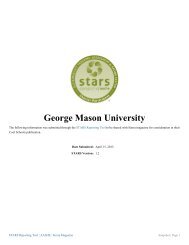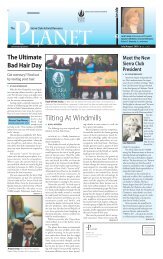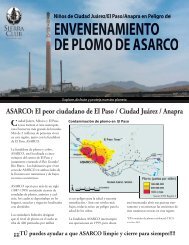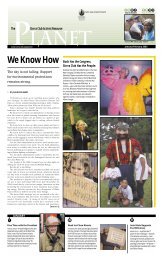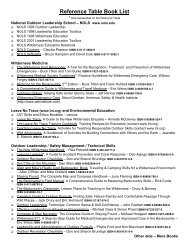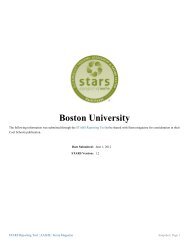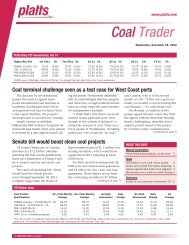FAITH IN ACTION - Sierra Club
FAITH IN ACTION - Sierra Club
FAITH IN ACTION - Sierra Club
Create successful ePaper yourself
Turn your PDF publications into a flip-book with our unique Google optimized e-Paper software.
Jim Margadant<br />
HILL CITY, SD<br />
The staff members at Borderlands Education and Spiritual Center<br />
recognize that nature holds immeasurable value because it is an<br />
avenue through which many people come to experience God.<br />
“According to the Christian tradition, there are two means through<br />
which the character of God is revealed to us: through scripture and<br />
God’s creation,” explains the Rev. Linda Kramer, an Episcopalian<br />
priest and Borderlands Center director. Borderlands Center seeks to<br />
introduce visitors to the splendor of nature, instruct them on sustainable<br />
living and preserve the unique prairie wherein it is located.<br />
Borderlands Center, an interfaith facility, is situated in the rolling<br />
hills of the Pe Sla, or Reynolds Prairie, which is surrounded by<br />
NASHVILLE, TN<br />
To Joyce Wilding, caring for the environment<br />
should be central to a Christian’s life. “To have<br />
peace on earth, we must have peace with the<br />
earth,” reflects Wilding, Environmental<br />
Ministry leader at Christ Church Episcopal<br />
Cathedral in Nashville, Tennessee.<br />
The Christ Church Environmental Ministry has<br />
many sustainable initiatives, but their main<br />
focus is on water conservation and stewardship.<br />
“In Christianity, water symbolizes the hope of<br />
renewal. Water itself conveys this spiritual meaning through its properties<br />
of cleansing and healing. Yet we continue to destroy watersheds<br />
and contaminate many semi-pristine water sources,” says Wilding.<br />
“What does it mean when water is so scarce that our primary symbol<br />
of renewal is no longer available? Or when water is so contaminated<br />
that its capacity to heal has been lost?” asks Wilding.<br />
Embodying her thoughts, Christ Church Cathedral partners with<br />
the Cumberland River Compact (CRC) to protect and preserve the<br />
local Cumberland River and its tributaries. Church members participate<br />
in stream restoration projects, sustainable building programs,<br />
WHERE THE EARTH MEETS THE SKY<br />
pine forested mountains known as the Black Hills. “It is one of<br />
the few places left where you can still hear the silence and see the<br />
stars at night,” says Rev. Kramer. Antelope, elk, deer, wild turkey,<br />
coyotes and mountain lions live in the area, and wildflowers,<br />
herbs and medicinal plants cover the hills. According to Rev.<br />
Kramer, many people visit Borderlands Center to seek God in this<br />
pristine natural setting.<br />
Unfortunately, development is encroaching on the unspoiled Pe<br />
Sla prairie, a place that is sacred to the Oceti Sakowin Oyate<br />
(Seven Fires Nation) of Lakota, Dakota and Nakota people. Pe Sla<br />
means “peace at the bare spot.” The prairie is a sacred area of prayer<br />
for peace and healing where the Lakota continue to hold ceremonies<br />
and pilgrimages. Lakota spirituality is incorporated into<br />
many of Borderlands Center’s educational and spiritual programs.<br />
Borderlands Center is spearheading efforts to preserve the prairie,<br />
including a large tract of land that had been put on the market for<br />
development. Today, they are raising money to protect more vulnerable<br />
land and organizing a Neighbors Coalition to coordinate<br />
preservation efforts. “Places like Reynolds Prairie, where one can<br />
look all around and see nothing but nature, are vital.... We need<br />
to remember that sometimes contributing to our world means<br />
leaving it just as it is,” concludes Rev. Kramer.<br />
LIV<strong>IN</strong>G WATER<br />
and educational events. Members are encouraged<br />
to grow native plants, which require less<br />
water, in their yards and at their workplaces.<br />
Each year, the Environmental Ministry hosts<br />
“Weeds to Wreaths,” an intergenerational project<br />
to remove invasive plants. Removing invasive<br />
plants encourages native plants to grow,<br />
which are adapted to local rainfall, soil and temperature<br />
conditions. The church members use<br />
the pulled vines for the base of Advent wreaths.<br />
Ministry leaders have sold water “gifts” at the<br />
parish Alternative Christmas Fair, including funds for CRC rain gardens,<br />
native plants, and water-related educational projects.<br />
Recently, Christ Church Cathedral launched an effort to eliminate<br />
bottled water use, educating its members and the public about the<br />
withdrawal of large quantities of water from springs and aquifers for<br />
bottling. Water bottling has depleted household wells in rural areas,<br />
damaged wetlands, and degraded aquifers, and each year billions of<br />
plastic water bottles end up as garbage or litter. The Cathedral<br />
encourages members to purchase reusable drinking containers, and<br />
they have eliminated bottled water from church events.<br />
27



